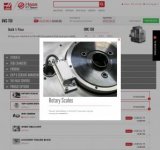I can get a slightly used 2019 model UMC-750 for a really good price and I don't know any one who owns one so I searched the web on UMC's and I am a bit puzzled
If I am correct Haas uses HRT-450 rotary for their B-Axis;

Haas also modified the original air actuated rotary brake boosters onb the B-Axis with a hydraulic power brakes, it seems like they even offered a retrofit kits for this upgrade;
https://www.haascnc.com/service/tro...aulic-power-brake---retrofit-kit---ad0440.pdf
A fellow user stated the accuracy of the machine as follows;
UMC-750 Applications Troubleshooting Guide
^ Are these "Accuracy Errors" and "Surface Finish Problems" worst case scenarios or common numbers for UMC-750? Since Haas tweaks-improves their machines, is there a change that 2019 model UMC-750 might be better?
Or are these error are caused by low resolution rotary scales and lack of scales on linear axes??
Strategies for solving UMC surface finish problems
Can I really improve accuracy, finish quality by tweaking the code and using milling chucks or shrink-fit holders and tweaking the code?
Further more they redesigned their rotaries with Cycloidal Rotary Drives on UMC-500 and UMC-1000 and I guess they are going to refresh UMC-750 soon.
UMC-750's cutting and rapid speeds are really far apart compared to other Haas machines [1200ipm vs 650ipm] UMC-750 moves like SS [1400ipm] and cuts as fast as regular VF [650 ipm].
Weirdly, UMC-750 and UMC-750SS's Feedrates are identically same on the Haas's website, I guess they might did an error on the website.
Any comment will be vastly appreciated.
My other alternative is a equivalently used and specd 3+2 DMG MORI CMX 50 U which costs %20 more, offer bigger table but smaller work envelop and comes with linear scales.
If I am correct Haas uses HRT-450 rotary for their B-Axis;

Haas also modified the original air actuated rotary brake boosters onb the B-Axis with a hydraulic power brakes, it seems like they even offered a retrofit kits for this upgrade;
https://www.haascnc.com/service/tro...aulic-power-brake---retrofit-kit---ad0440.pdf
A fellow user stated the accuracy of the machine as follows;
X Pos, ±0.0002” Rep. ±0.0001"
Y Pos, ±0.0002” Rep. ±0.0001"
Z Pos, ±0.0002” Rep. ±0.0001"
B Pos, ±15 arc-sec Re. 10 arc-sec
C Pos, ±15 arc-sec Rep. 10 arc-sec
Source
UMC-750 Applications Troubleshooting Guide
When Drilling From B90 C0 to B90 C180 The Holes Don't Line Up:
On a UMC-750, when using a drill from two sides of a part you can get up to 0.002 inch (0.051 mm) error per side.
This can add up to a total of 0.004 inch (0.102 mm) mismatch between the two drilled holes.
Use a probe to get separate offsets for the B90 C0 and B90 C180 side. This can reduce this mismatch error.
^ Are these "Accuracy Errors" and "Surface Finish Problems" worst case scenarios or common numbers for UMC-750? Since Haas tweaks-improves their machines, is there a change that 2019 model UMC-750 might be better?
Or are these error are caused by low resolution rotary scales and lack of scales on linear axes??
Strategies for solving UMC surface finish problems
Make sure the tooling is correct for the application. Gage length should be as short as possible. Use milling chucks or shrink-fit holders. If that's not possible use ER collets. Avoid Weldon shank holders. Endmill runout needs to be under 0.0005�. Balance all tools that turn 10,000rpm or more to grade G2.5 or better
Can I really improve accuracy, finish quality by tweaking the code and using milling chucks or shrink-fit holders and tweaking the code?
----
Further more they redesigned their rotaries with Cycloidal Rotary Drives on UMC-500 and UMC-1000 and I guess they are going to refresh UMC-750 soon.
| UMC-500 | UMC-750 | UMC-1000 | |
| B-Axis / Max Torque | 1854 ft-lbf | 400 ft-lbf | 2240 ft-lbf |
| B-Axis / Brake Torque | 900 ft-lbf | 1800 ft-lbf | 2000 ft-lbf |
| C-Axis / Max Torque | 1854 ft-lbf | 300 ft-lbf | 1854 ft-lbf |
| C-Axis / Brake Torque | 900 ft-lbf | 500 ft-lbf | 900 ft-lbf |
UMC-750's cutting and rapid speeds are really far apart compared to other Haas machines [1200ipm vs 650ipm] UMC-750 moves like SS [1400ipm] and cuts as fast as regular VF [650 ipm].
Weirdly, UMC-750 and UMC-750SS's Feedrates are identically same on the Haas's website, I guess they might did an error on the website.
Any comment will be vastly appreciated.
My other alternative is a equivalently used and specd 3+2 DMG MORI CMX 50 U which costs %20 more, offer bigger table but smaller work envelop and comes with linear scales.



 That is true, BUT easy to fix by probing a known feature / hole when rotating to other side of part. I didn't get to full 5 axis on it, but full 4th axis and speeds and finish were acceptable for us. Not silky smooth, but visually fine (was cosmetic, no Ra value needed).
That is true, BUT easy to fix by probing a known feature / hole when rotating to other side of part. I didn't get to full 5 axis on it, but full 4th axis and speeds and finish were acceptable for us. Not silky smooth, but visually fine (was cosmetic, no Ra value needed).


